Organizational Behavior: A Study of Organizational Change Factors
VerifiedAdded on 2023/06/14
|8
|1972
|73
Essay
AI Summary
This essay provides a comprehensive analysis of organizational change and behavior, drawing upon provided articles to examine the factors influencing organizational change. It emphasizes the complexity of organizational change processes, highlighting the importance of understanding the dynamics discussed in the articles. The essay explores the role of internal and external forces driving change, referencing the 'burning platform' concept to illustrate the urgency for organizations to adapt. It identifies key change agents and discusses their impact on organizational performance, addressing potential flaws in mental models and emphasizing the importance of effective communication and knowledge transfer. The essay concludes by underscoring that organizational change is a complex procedure and stresses the need for organizations to navigate the change process effectively to achieve their business objectives and implement desired strategies.
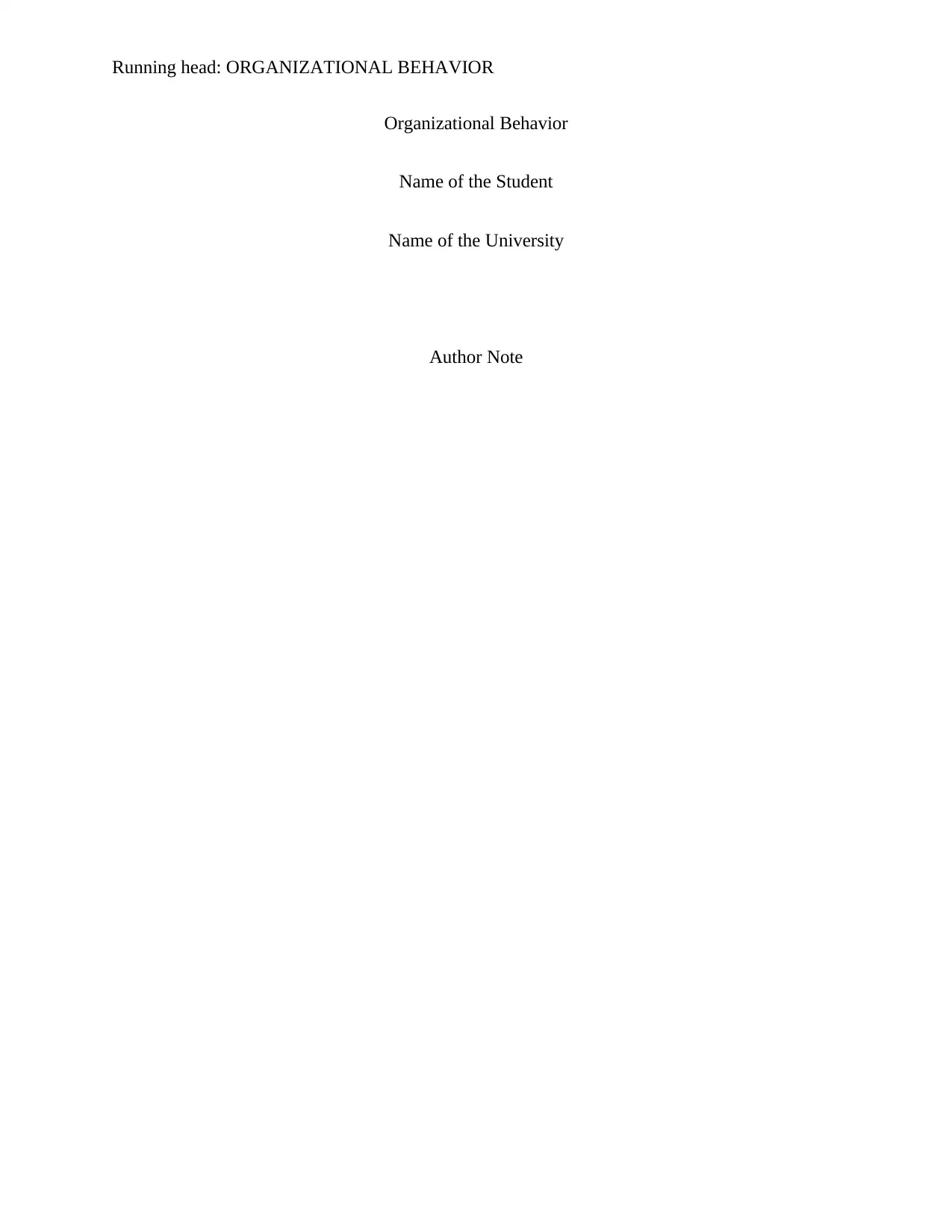
Running head: ORGANIZATIONAL BEHAVIOR
Organizational Behavior
Name of the Student
Name of the University
Author Note
Organizational Behavior
Name of the Student
Name of the University
Author Note
Paraphrase This Document
Need a fresh take? Get an instant paraphrase of this document with our AI Paraphraser
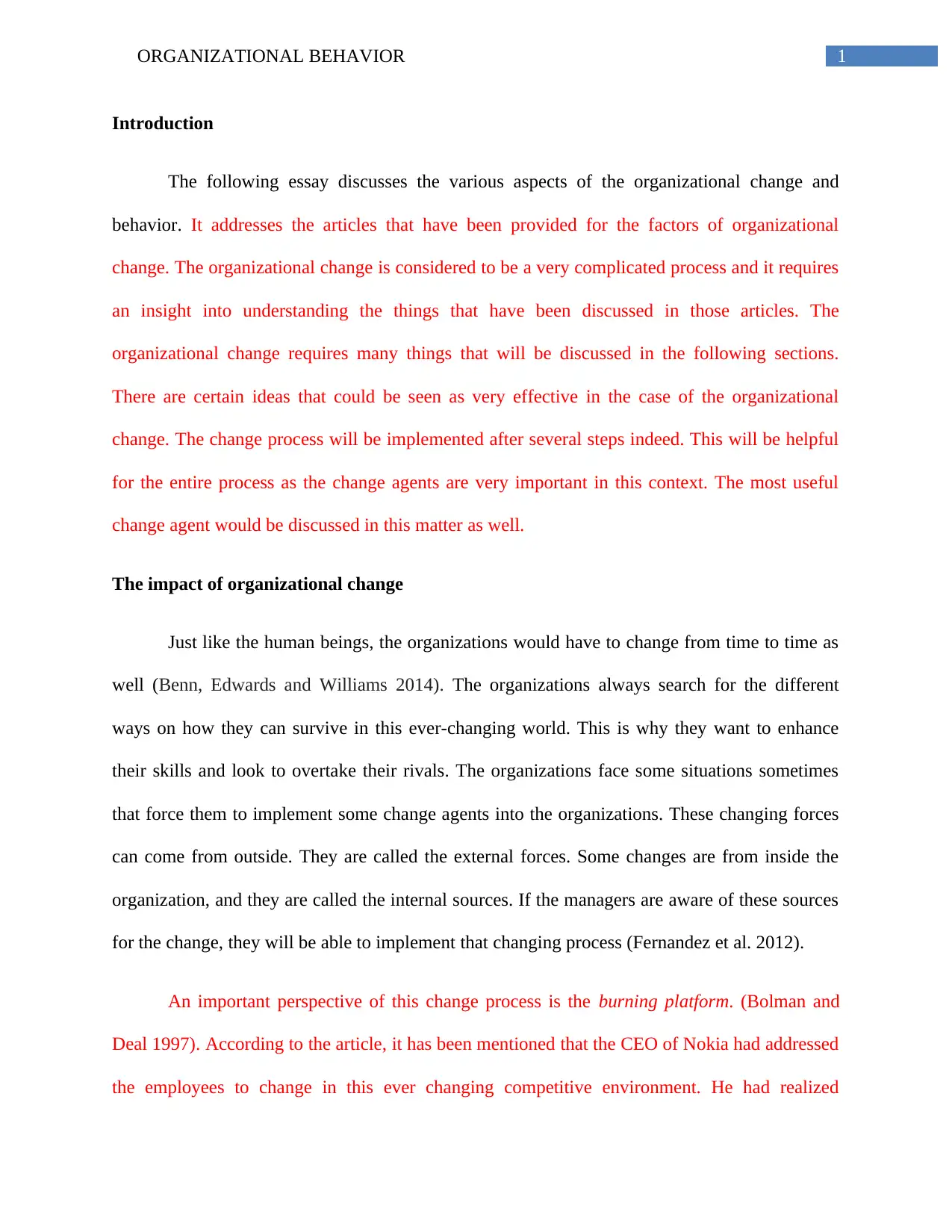
1ORGANIZATIONAL BEHAVIOR
Introduction
The following essay discusses the various aspects of the organizational change and
behavior. It addresses the articles that have been provided for the factors of organizational
change. The organizational change is considered to be a very complicated process and it requires
an insight into understanding the things that have been discussed in those articles. The
organizational change requires many things that will be discussed in the following sections.
There are certain ideas that could be seen as very effective in the case of the organizational
change. The change process will be implemented after several steps indeed. This will be helpful
for the entire process as the change agents are very important in this context. The most useful
change agent would be discussed in this matter as well.
The impact of organizational change
Just like the human beings, the organizations would have to change from time to time as
well (Benn, Edwards and Williams 2014). The organizations always search for the different
ways on how they can survive in this ever-changing world. This is why they want to enhance
their skills and look to overtake their rivals. The organizations face some situations sometimes
that force them to implement some change agents into the organizations. These changing forces
can come from outside. They are called the external forces. Some changes are from inside the
organization, and they are called the internal sources. If the managers are aware of these sources
for the change, they will be able to implement that changing process (Fernandez et al. 2012).
An important perspective of this change process is the burning platform. (Bolman and
Deal 1997). According to the article, it has been mentioned that the CEO of Nokia had addressed
the employees to change in this ever changing competitive environment. He had realized
Introduction
The following essay discusses the various aspects of the organizational change and
behavior. It addresses the articles that have been provided for the factors of organizational
change. The organizational change is considered to be a very complicated process and it requires
an insight into understanding the things that have been discussed in those articles. The
organizational change requires many things that will be discussed in the following sections.
There are certain ideas that could be seen as very effective in the case of the organizational
change. The change process will be implemented after several steps indeed. This will be helpful
for the entire process as the change agents are very important in this context. The most useful
change agent would be discussed in this matter as well.
The impact of organizational change
Just like the human beings, the organizations would have to change from time to time as
well (Benn, Edwards and Williams 2014). The organizations always search for the different
ways on how they can survive in this ever-changing world. This is why they want to enhance
their skills and look to overtake their rivals. The organizations face some situations sometimes
that force them to implement some change agents into the organizations. These changing forces
can come from outside. They are called the external forces. Some changes are from inside the
organization, and they are called the internal sources. If the managers are aware of these sources
for the change, they will be able to implement that changing process (Fernandez et al. 2012).
An important perspective of this change process is the burning platform. (Bolman and
Deal 1997). According to the article, it has been mentioned that the CEO of Nokia had addressed
the employees to change in this ever changing competitive environment. He had realized
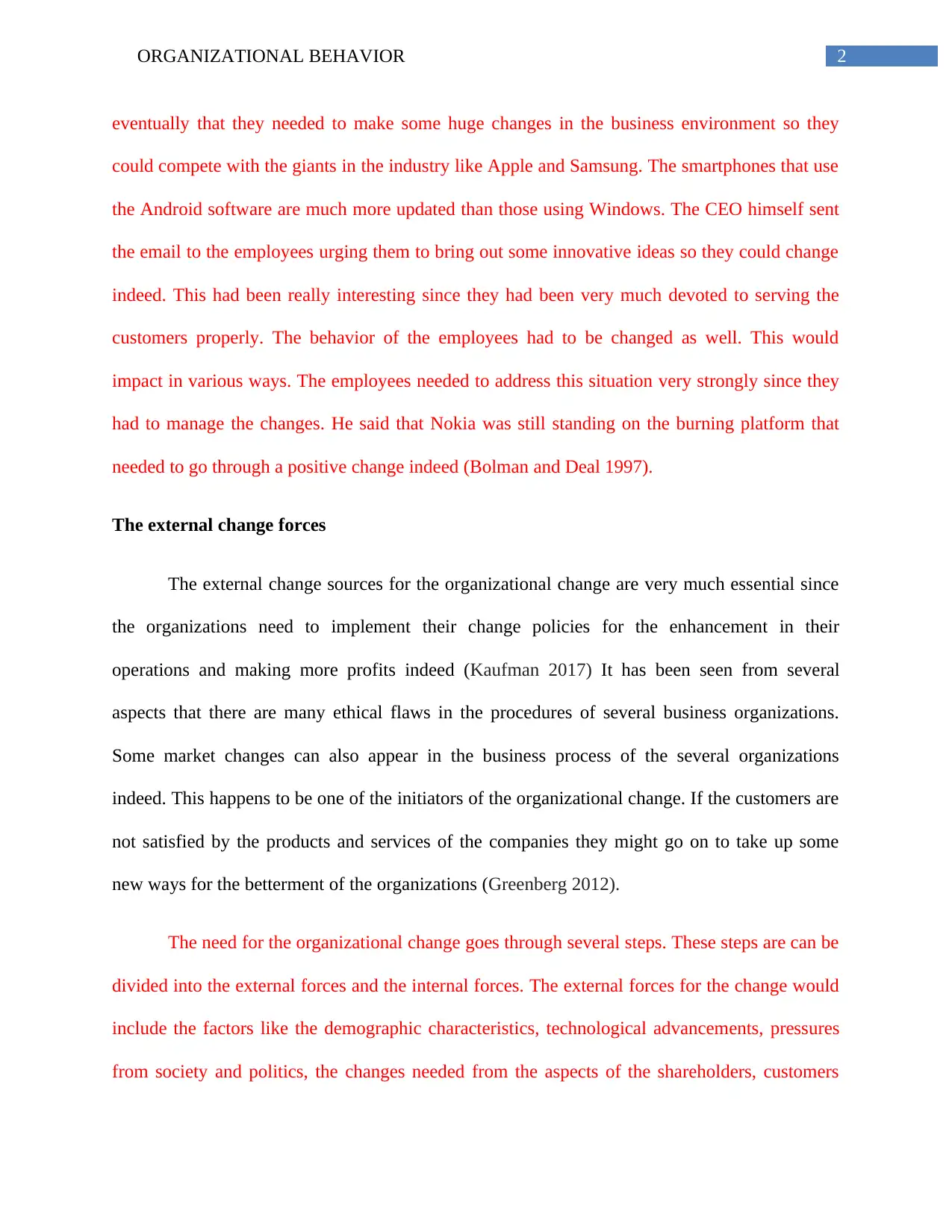
2ORGANIZATIONAL BEHAVIOR
eventually that they needed to make some huge changes in the business environment so they
could compete with the giants in the industry like Apple and Samsung. The smartphones that use
the Android software are much more updated than those using Windows. The CEO himself sent
the email to the employees urging them to bring out some innovative ideas so they could change
indeed. This had been really interesting since they had been very much devoted to serving the
customers properly. The behavior of the employees had to be changed as well. This would
impact in various ways. The employees needed to address this situation very strongly since they
had to manage the changes. He said that Nokia was still standing on the burning platform that
needed to go through a positive change indeed (Bolman and Deal 1997).
The external change forces
The external change sources for the organizational change are very much essential since
the organizations need to implement their change policies for the enhancement in their
operations and making more profits indeed (Kaufman 2017) It has been seen from several
aspects that there are many ethical flaws in the procedures of several business organizations.
Some market changes can also appear in the business process of the several organizations
indeed. This happens to be one of the initiators of the organizational change. If the customers are
not satisfied by the products and services of the companies they might go on to take up some
new ways for the betterment of the organizations (Greenberg 2012).
The need for the organizational change goes through several steps. These steps are can be
divided into the external forces and the internal forces. The external forces for the change would
include the factors like the demographic characteristics, technological advancements, pressures
from society and politics, the changes needed from the aspects of the shareholders, customers
eventually that they needed to make some huge changes in the business environment so they
could compete with the giants in the industry like Apple and Samsung. The smartphones that use
the Android software are much more updated than those using Windows. The CEO himself sent
the email to the employees urging them to bring out some innovative ideas so they could change
indeed. This had been really interesting since they had been very much devoted to serving the
customers properly. The behavior of the employees had to be changed as well. This would
impact in various ways. The employees needed to address this situation very strongly since they
had to manage the changes. He said that Nokia was still standing on the burning platform that
needed to go through a positive change indeed (Bolman and Deal 1997).
The external change forces
The external change sources for the organizational change are very much essential since
the organizations need to implement their change policies for the enhancement in their
operations and making more profits indeed (Kaufman 2017) It has been seen from several
aspects that there are many ethical flaws in the procedures of several business organizations.
Some market changes can also appear in the business process of the several organizations
indeed. This happens to be one of the initiators of the organizational change. If the customers are
not satisfied by the products and services of the companies they might go on to take up some
new ways for the betterment of the organizations (Greenberg 2012).
The need for the organizational change goes through several steps. These steps are can be
divided into the external forces and the internal forces. The external forces for the change would
include the factors like the demographic characteristics, technological advancements, pressures
from society and politics, the changes needed from the aspects of the shareholders, customers
⊘ This is a preview!⊘
Do you want full access?
Subscribe today to unlock all pages.

Trusted by 1+ million students worldwide
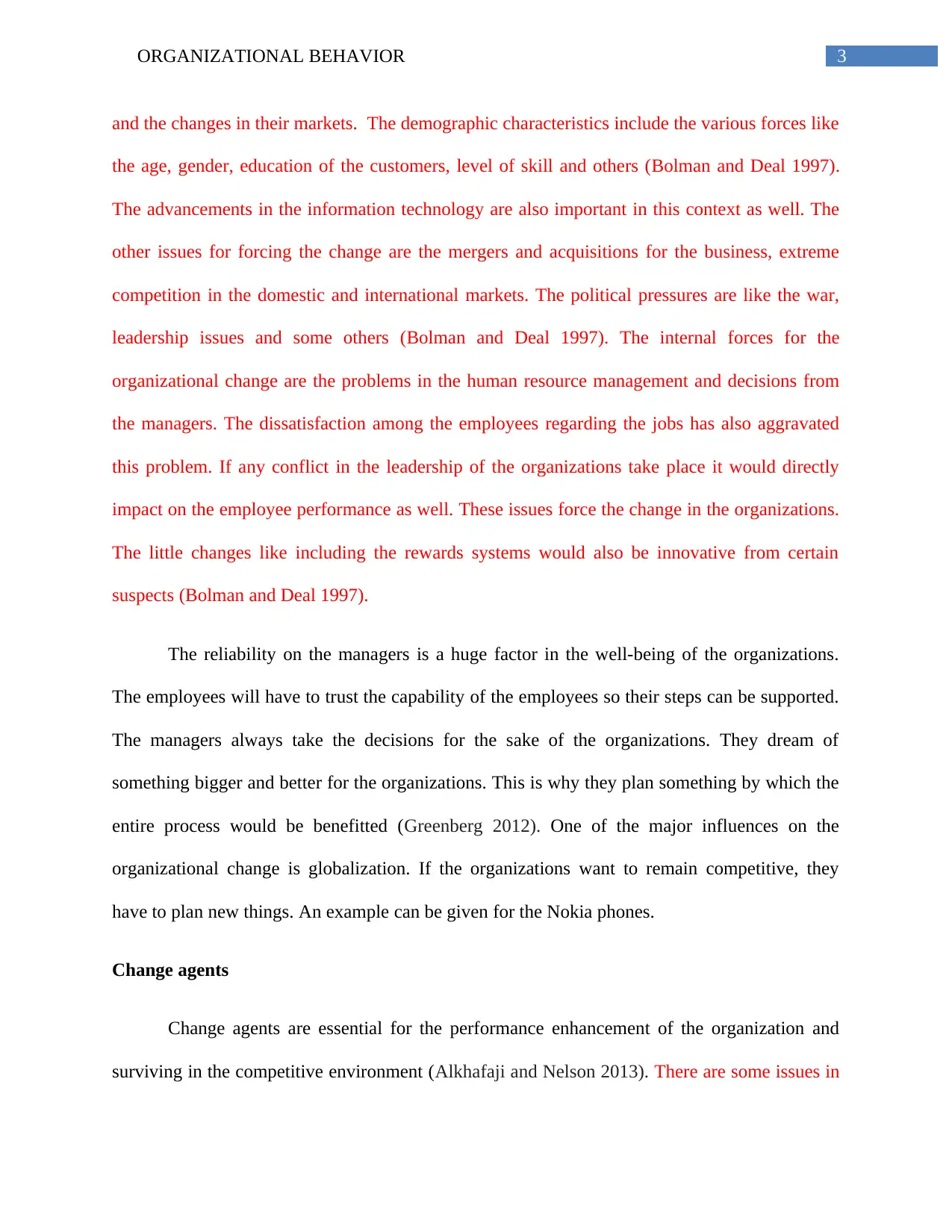
3ORGANIZATIONAL BEHAVIOR
and the changes in their markets. The demographic characteristics include the various forces like
the age, gender, education of the customers, level of skill and others (Bolman and Deal 1997).
The advancements in the information technology are also important in this context as well. The
other issues for forcing the change are the mergers and acquisitions for the business, extreme
competition in the domestic and international markets. The political pressures are like the war,
leadership issues and some others (Bolman and Deal 1997). The internal forces for the
organizational change are the problems in the human resource management and decisions from
the managers. The dissatisfaction among the employees regarding the jobs has also aggravated
this problem. If any conflict in the leadership of the organizations take place it would directly
impact on the employee performance as well. These issues force the change in the organizations.
The little changes like including the rewards systems would also be innovative from certain
suspects (Bolman and Deal 1997).
The reliability on the managers is a huge factor in the well-being of the organizations.
The employees will have to trust the capability of the employees so their steps can be supported.
The managers always take the decisions for the sake of the organizations. They dream of
something bigger and better for the organizations. This is why they plan something by which the
entire process would be benefitted (Greenberg 2012). One of the major influences on the
organizational change is globalization. If the organizations want to remain competitive, they
have to plan new things. An example can be given for the Nokia phones.
Change agents
Change agents are essential for the performance enhancement of the organization and
surviving in the competitive environment (Alkhafaji and Nelson 2013). There are some issues in
and the changes in their markets. The demographic characteristics include the various forces like
the age, gender, education of the customers, level of skill and others (Bolman and Deal 1997).
The advancements in the information technology are also important in this context as well. The
other issues for forcing the change are the mergers and acquisitions for the business, extreme
competition in the domestic and international markets. The political pressures are like the war,
leadership issues and some others (Bolman and Deal 1997). The internal forces for the
organizational change are the problems in the human resource management and decisions from
the managers. The dissatisfaction among the employees regarding the jobs has also aggravated
this problem. If any conflict in the leadership of the organizations take place it would directly
impact on the employee performance as well. These issues force the change in the organizations.
The little changes like including the rewards systems would also be innovative from certain
suspects (Bolman and Deal 1997).
The reliability on the managers is a huge factor in the well-being of the organizations.
The employees will have to trust the capability of the employees so their steps can be supported.
The managers always take the decisions for the sake of the organizations. They dream of
something bigger and better for the organizations. This is why they plan something by which the
entire process would be benefitted (Greenberg 2012). One of the major influences on the
organizational change is globalization. If the organizations want to remain competitive, they
have to plan new things. An example can be given for the Nokia phones.
Change agents
Change agents are essential for the performance enhancement of the organization and
surviving in the competitive environment (Alkhafaji and Nelson 2013). There are some issues in
Paraphrase This Document
Need a fresh take? Get an instant paraphrase of this document with our AI Paraphraser
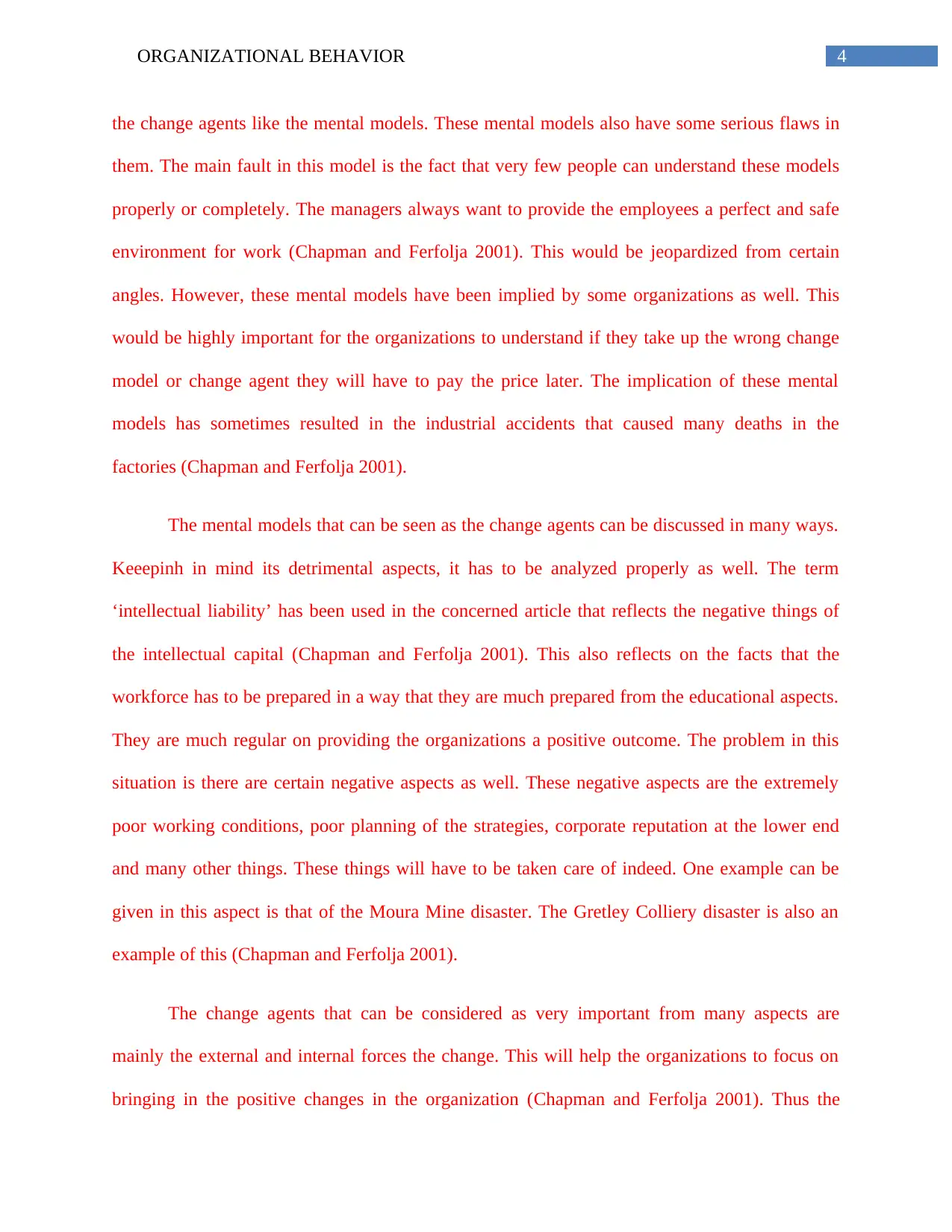
4ORGANIZATIONAL BEHAVIOR
the change agents like the mental models. These mental models also have some serious flaws in
them. The main fault in this model is the fact that very few people can understand these models
properly or completely. The managers always want to provide the employees a perfect and safe
environment for work (Chapman and Ferfolja 2001). This would be jeopardized from certain
angles. However, these mental models have been implied by some organizations as well. This
would be highly important for the organizations to understand if they take up the wrong change
model or change agent they will have to pay the price later. The implication of these mental
models has sometimes resulted in the industrial accidents that caused many deaths in the
factories (Chapman and Ferfolja 2001).
The mental models that can be seen as the change agents can be discussed in many ways.
Keeepinh in mind its detrimental aspects, it has to be analyzed properly as well. The term
‘intellectual liability’ has been used in the concerned article that reflects the negative things of
the intellectual capital (Chapman and Ferfolja 2001). This also reflects on the facts that the
workforce has to be prepared in a way that they are much prepared from the educational aspects.
They are much regular on providing the organizations a positive outcome. The problem in this
situation is there are certain negative aspects as well. These negative aspects are the extremely
poor working conditions, poor planning of the strategies, corporate reputation at the lower end
and many other things. These things will have to be taken care of indeed. One example can be
given in this aspect is that of the Moura Mine disaster. The Gretley Colliery disaster is also an
example of this (Chapman and Ferfolja 2001).
The change agents that can be considered as very important from many aspects are
mainly the external and internal forces the change. This will help the organizations to focus on
bringing in the positive changes in the organization (Chapman and Ferfolja 2001). Thus the
the change agents like the mental models. These mental models also have some serious flaws in
them. The main fault in this model is the fact that very few people can understand these models
properly or completely. The managers always want to provide the employees a perfect and safe
environment for work (Chapman and Ferfolja 2001). This would be jeopardized from certain
angles. However, these mental models have been implied by some organizations as well. This
would be highly important for the organizations to understand if they take up the wrong change
model or change agent they will have to pay the price later. The implication of these mental
models has sometimes resulted in the industrial accidents that caused many deaths in the
factories (Chapman and Ferfolja 2001).
The mental models that can be seen as the change agents can be discussed in many ways.
Keeepinh in mind its detrimental aspects, it has to be analyzed properly as well. The term
‘intellectual liability’ has been used in the concerned article that reflects the negative things of
the intellectual capital (Chapman and Ferfolja 2001). This also reflects on the facts that the
workforce has to be prepared in a way that they are much prepared from the educational aspects.
They are much regular on providing the organizations a positive outcome. The problem in this
situation is there are certain negative aspects as well. These negative aspects are the extremely
poor working conditions, poor planning of the strategies, corporate reputation at the lower end
and many other things. These things will have to be taken care of indeed. One example can be
given in this aspect is that of the Moura Mine disaster. The Gretley Colliery disaster is also an
example of this (Chapman and Ferfolja 2001).
The change agents that can be considered as very important from many aspects are
mainly the external and internal forces the change. This will help the organizations to focus on
bringing in the positive changes in the organization (Chapman and Ferfolja 2001). Thus the
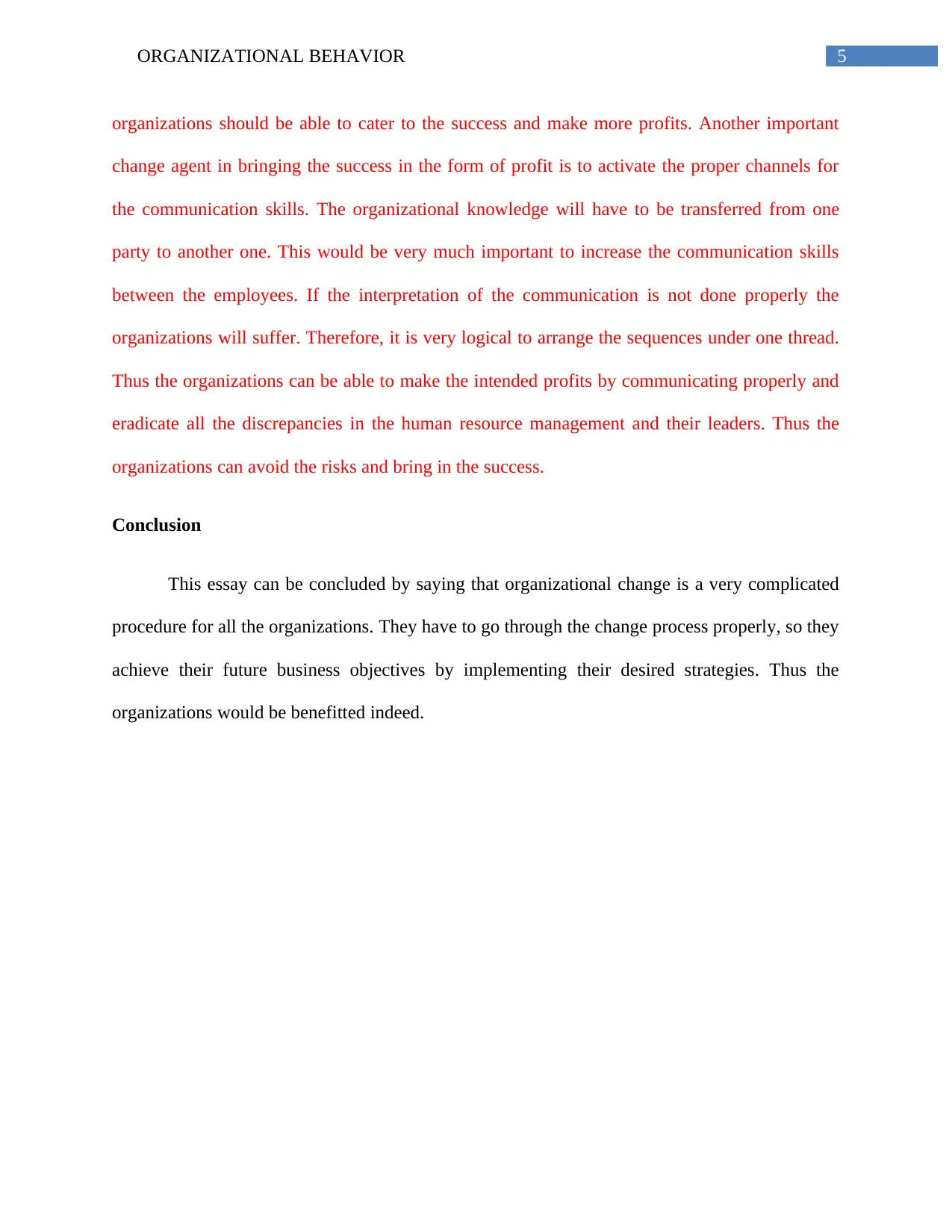
5ORGANIZATIONAL BEHAVIOR
organizations should be able to cater to the success and make more profits. Another important
change agent in bringing the success in the form of profit is to activate the proper channels for
the communication skills. The organizational knowledge will have to be transferred from one
party to another one. This would be very much important to increase the communication skills
between the employees. If the interpretation of the communication is not done properly the
organizations will suffer. Therefore, it is very logical to arrange the sequences under one thread.
Thus the organizations can be able to make the intended profits by communicating properly and
eradicate all the discrepancies in the human resource management and their leaders. Thus the
organizations can avoid the risks and bring in the success.
Conclusion
This essay can be concluded by saying that organizational change is a very complicated
procedure for all the organizations. They have to go through the change process properly, so they
achieve their future business objectives by implementing their desired strategies. Thus the
organizations would be benefitted indeed.
organizations should be able to cater to the success and make more profits. Another important
change agent in bringing the success in the form of profit is to activate the proper channels for
the communication skills. The organizational knowledge will have to be transferred from one
party to another one. This would be very much important to increase the communication skills
between the employees. If the interpretation of the communication is not done properly the
organizations will suffer. Therefore, it is very logical to arrange the sequences under one thread.
Thus the organizations can be able to make the intended profits by communicating properly and
eradicate all the discrepancies in the human resource management and their leaders. Thus the
organizations can avoid the risks and bring in the success.
Conclusion
This essay can be concluded by saying that organizational change is a very complicated
procedure for all the organizations. They have to go through the change process properly, so they
achieve their future business objectives by implementing their desired strategies. Thus the
organizations would be benefitted indeed.
⊘ This is a preview!⊘
Do you want full access?
Subscribe today to unlock all pages.

Trusted by 1+ million students worldwide
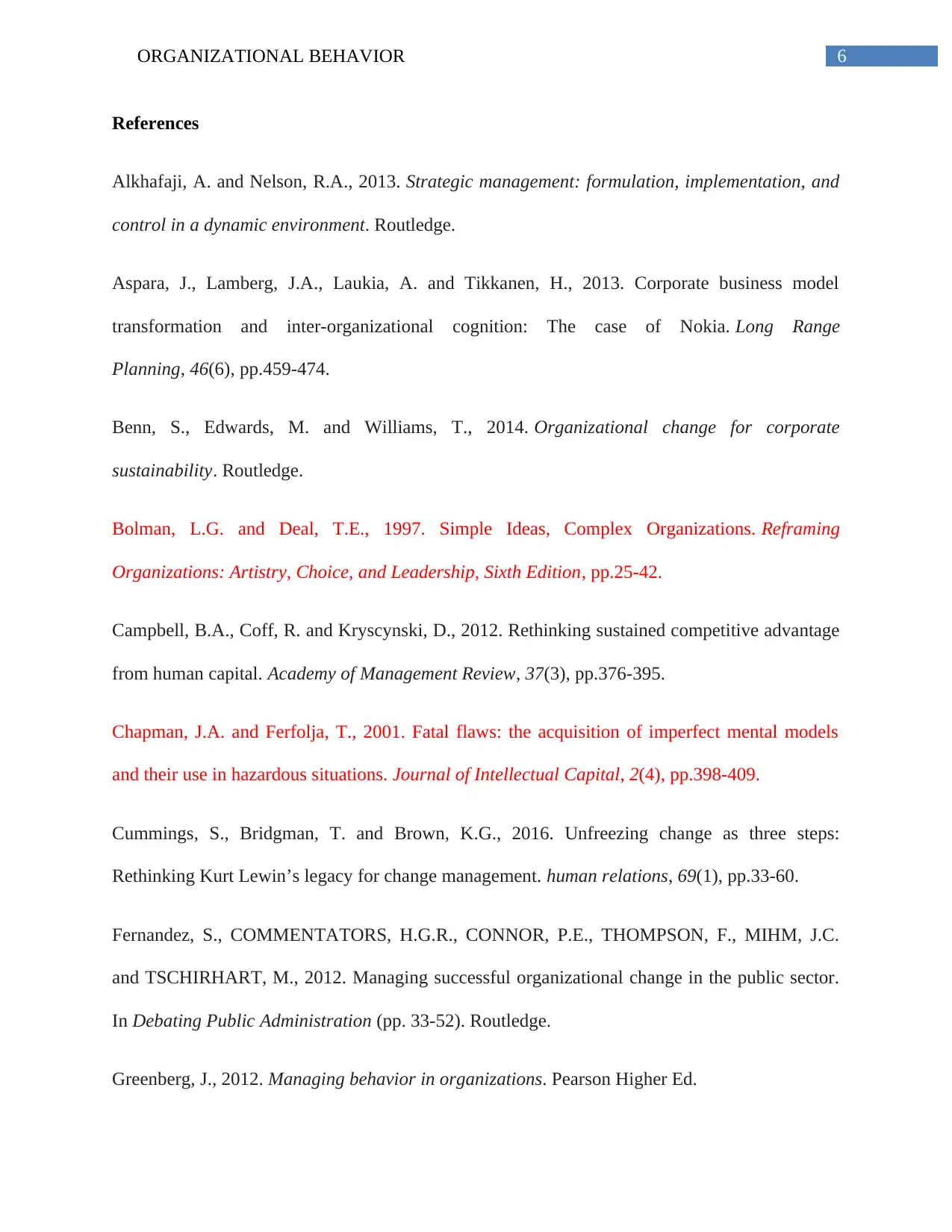
6ORGANIZATIONAL BEHAVIOR
References
Alkhafaji, A. and Nelson, R.A., 2013. Strategic management: formulation, implementation, and
control in a dynamic environment. Routledge.
Aspara, J., Lamberg, J.A., Laukia, A. and Tikkanen, H., 2013. Corporate business model
transformation and inter-organizational cognition: The case of Nokia. Long Range
Planning, 46(6), pp.459-474.
Benn, S., Edwards, M. and Williams, T., 2014. Organizational change for corporate
sustainability. Routledge.
Bolman, L.G. and Deal, T.E., 1997. Simple Ideas, Complex Organizations. Reframing
Organizations: Artistry, Choice, and Leadership, Sixth Edition, pp.25-42.
Campbell, B.A., Coff, R. and Kryscynski, D., 2012. Rethinking sustained competitive advantage
from human capital. Academy of Management Review, 37(3), pp.376-395.
Chapman, J.A. and Ferfolja, T., 2001. Fatal flaws: the acquisition of imperfect mental models
and their use in hazardous situations. Journal of Intellectual Capital, 2(4), pp.398-409.
Cummings, S., Bridgman, T. and Brown, K.G., 2016. Unfreezing change as three steps:
Rethinking Kurt Lewin’s legacy for change management. human relations, 69(1), pp.33-60.
Fernandez, S., COMMENTATORS, H.G.R., CONNOR, P.E., THOMPSON, F., MIHM, J.C.
and TSCHIRHART, M., 2012. Managing successful organizational change in the public sector.
In Debating Public Administration (pp. 33-52). Routledge.
Greenberg, J., 2012. Managing behavior in organizations. Pearson Higher Ed.
References
Alkhafaji, A. and Nelson, R.A., 2013. Strategic management: formulation, implementation, and
control in a dynamic environment. Routledge.
Aspara, J., Lamberg, J.A., Laukia, A. and Tikkanen, H., 2013. Corporate business model
transformation and inter-organizational cognition: The case of Nokia. Long Range
Planning, 46(6), pp.459-474.
Benn, S., Edwards, M. and Williams, T., 2014. Organizational change for corporate
sustainability. Routledge.
Bolman, L.G. and Deal, T.E., 1997. Simple Ideas, Complex Organizations. Reframing
Organizations: Artistry, Choice, and Leadership, Sixth Edition, pp.25-42.
Campbell, B.A., Coff, R. and Kryscynski, D., 2012. Rethinking sustained competitive advantage
from human capital. Academy of Management Review, 37(3), pp.376-395.
Chapman, J.A. and Ferfolja, T., 2001. Fatal flaws: the acquisition of imperfect mental models
and their use in hazardous situations. Journal of Intellectual Capital, 2(4), pp.398-409.
Cummings, S., Bridgman, T. and Brown, K.G., 2016. Unfreezing change as three steps:
Rethinking Kurt Lewin’s legacy for change management. human relations, 69(1), pp.33-60.
Fernandez, S., COMMENTATORS, H.G.R., CONNOR, P.E., THOMPSON, F., MIHM, J.C.
and TSCHIRHART, M., 2012. Managing successful organizational change in the public sector.
In Debating Public Administration (pp. 33-52). Routledge.
Greenberg, J., 2012. Managing behavior in organizations. Pearson Higher Ed.
Paraphrase This Document
Need a fresh take? Get an instant paraphrase of this document with our AI Paraphraser

7ORGANIZATIONAL BEHAVIOR
Jabri, M., 2017. Managing organizational change: Process, social construction and dialogue.
Palgrave.
Kaufman, H., 2017. The limits of organizational change. Routledge.
Van den Heuvel, M., Demerouti, E., Bakker, A.B. and Schaufeli, W.B., 2013. Adapting to
change: The value of change information and meaning-making. Journal of Vocational
Behavior, 83(1), pp.11-21.
Jabri, M., 2017. Managing organizational change: Process, social construction and dialogue.
Palgrave.
Kaufman, H., 2017. The limits of organizational change. Routledge.
Van den Heuvel, M., Demerouti, E., Bakker, A.B. and Schaufeli, W.B., 2013. Adapting to
change: The value of change information and meaning-making. Journal of Vocational
Behavior, 83(1), pp.11-21.
1 out of 8
Related Documents
Your All-in-One AI-Powered Toolkit for Academic Success.
+13062052269
info@desklib.com
Available 24*7 on WhatsApp / Email
![[object Object]](/_next/static/media/star-bottom.7253800d.svg)
Unlock your academic potential
Copyright © 2020–2025 A2Z Services. All Rights Reserved. Developed and managed by ZUCOL.




